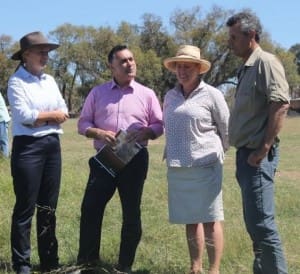
At the wool report launch from left, Minister for Primary Industries Katrina Hodgkinson, Member for Monaro John Barilaro and wool producers Sarah and Robert Hyles.
NSW’s sheep industry should develop a strategic plan to 2025 and beyond, according to a government report released this week.
The authors of the NSW Wool Industry and Future Opportunities report said of overarching importance is the need to develop a preferred future for the NSW sheep industry, one that is owned and shared by industry, providing confidence to current stakeholders and future investors.
“To that end, the NSW sheep industry should develop a strategic plan to help guide the decisions of all stakeholders (producers, input suppliers, buyers, brokers, processors, industry service bodies, NSW Government, etc.) over the next decade and beyond.”
The state’s wool and sheep producers have until May 31 this year to provide feedback on the report to the NSW Department of Primary Industries by completing an online survey.
The report was released by NSW Minister for Primary Industries Katrina Hodgkinson and the Member for Monaro John Barilaro in Bungendore on Tuesday.
It was prepared for the NSW Department of Primary Industries by review consultants Russell Pattinson from Miracle Dog, Chris Wilcox from Poimena Analysis and Scott Williams Consulting, and DAFWA’s Kimbal Curtis.
Wool industry lacks direction and transparency
The report said their review into the sector heard that the wool industry lacks direction and transparency.
“The industry doesn’t have growth or a growth strategy.
“Wool is a competitive industry with a real image problem.”
The report said data says the industry is profitable but it is seen as poor and always whingeing about price and issues.
“The most important change for wool is that it is no longer a stand-alone industry.
“It is an important component of the sheep industry that produces lamb, wool and mutton,” the report said.
NSW wool producers need to purse productivity gains
The report made five recommendations for NSW wool producers that include:
– developing an understanding of product market segments
– setting long-term business goals
– attaining operational and planning skills
– pursuing productivity gains through best management practices
– including succession planning in the farm business plan
Report recommends transition to private farm advisory sector
The report’s recommendations for the NSW wool industry include:
– facilitating grower understanding of specific market requirements
– provide information packages on best practice sheep production
– drive innovation through leading edge research and development
– develop and recognise young industry leaders
– facilitate transition to a private farm advisory sector for best practice adoption
– consider the feasibility of a provenance-sustainability scheme for wool
Report recommends NSW DPI help cut red tape
The report’s recommendations for the NSW DPI are:
– Continue to provide biosecurity, animal health and welfare related services
– make reasonable efforts to reduce the impact of predation on sheep flocks
– facilitate broadacre benchmarking data on productivity and profitability on a regional level
– support industry-specific research and development
– commit to the next generation of R&D professionals and practitioners
– support the sheep industry by facilitating reductions in red tape.
NSW Government given a clear direction on wool
Ms Hodgkinson said the report provides the NSW Government with a clear direction on how we can help the wool industry to develop a way forward.
“We will now work with the sheep industry, including the wool sector, to develop a strategic plan to 2025. A plan that is owned and shared by the industry, and which provides confidence to current stakeholders and future investors.
“Future challenges for industry highlighted in the report include tight operating margins, animal welfare issues, risk of exotic diseases and predation from feral pests,” she said.
“The report also provides advice on how, at a farm level, wool producers can position their business to capitalise on future opportunities for the sector.”
Mr Barilaro said he welcomed the report and its efforts to find a way forward for the sheep and wool industry ensuring that it has a sustainable future with job security for its many thousands of workers in rural and regional communities.
Ms Hodgkinson said the NSW Wool Industry & Future Opportunities report delivers on goal 2 of the NSW Agriculture Industry Action Plan – a profitable and productive industry in NSW.
“The Agriculture Industry Action Plan is the NSW Government clear plan for growth in our State’s $12 billion primary industries sector,” said Ms Hodgkinson.
NSW DPI will now commence the consultation process with producers and industry to gain input into how it responds to the report and how to action the recommendations made for DPI.
The full report and synopsis is available from the DPI website at www.dpi.nsw.gov.au/agriculture
Wool and sheep producers can provide feedback to the NSW Department of Primary Industries by completing the on-line survey. This survey will be open until May 31, 2015.
Source: NSW Minister for Primary Industries, NSW DPI.

HAVE YOUR SAY